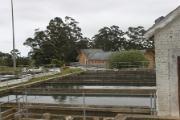
A TOP-LEVEL government delegation yesterday visited Grahamstown to see the progress that had been made in solving ongoing water outages.
The Presidential Infrastructure Coordinating Committee (PICC) delegation which included top officials from national and local government - was led by Rural Development and Land Reform Minister Gugile Nkwinti and Public Works Minister Thulas Nxesi. The group held lengthy meetings with local government politicians, Makana municipal officials, Rhodes University vice-chancellor Dr Sizwe Mabizela and senior campus management.
Although the media - including TV news - was officially invited by Makana spokeswoman Yoliswa Ramokolo to join the delegation as it visited key areas affected by water outages, and to attend a later media briefing, the group was told by Molefe Pule of the PICC that no statements would be made about the visit.
Earlier during a visit to Howiesonspoort pump station - which supplies large areas of Grahamstown - Amatola Water area operations manager Chris Nair told the delegation about interventions they had made over the past year to try and improve supply to the town.
He said antiquated equipment and a lack of expertise and maintenance over the years had placed the "pump station at the epicentre of the whole problem".
According to Nair new backup pumps had been procured, vital valves replaced and intelligent panels had been installed to monitor problems before they happened. This had boosted operational pump capacity at Howiesonspoort from 40 to 100 litres a second.
A new backup powerline was also being installed to keep pumps going even if the main line went down.
"We replaced 13 non-functional valves the nuts and bolts were so rusted you could not even put a spanner on them.
"It was not an easy task - we had to plan it in segments and stages." Makana's director of infrastructure and technical services, Thembinkosi Myalato, said further intervention was needed to desilt the dam and raise the height of the dam wall at Howiesonspoort.
Increasing the carrying capacity would help bring down the cost of buying water for the eastern parts of town which are supplied by a pipeline from the Fish River.
Attempts were also being made to prevent water wastage caused by leaking pipes and faulty toilet cisterns.
Article by: David Macgregor
Article source: Daily Dispatch
